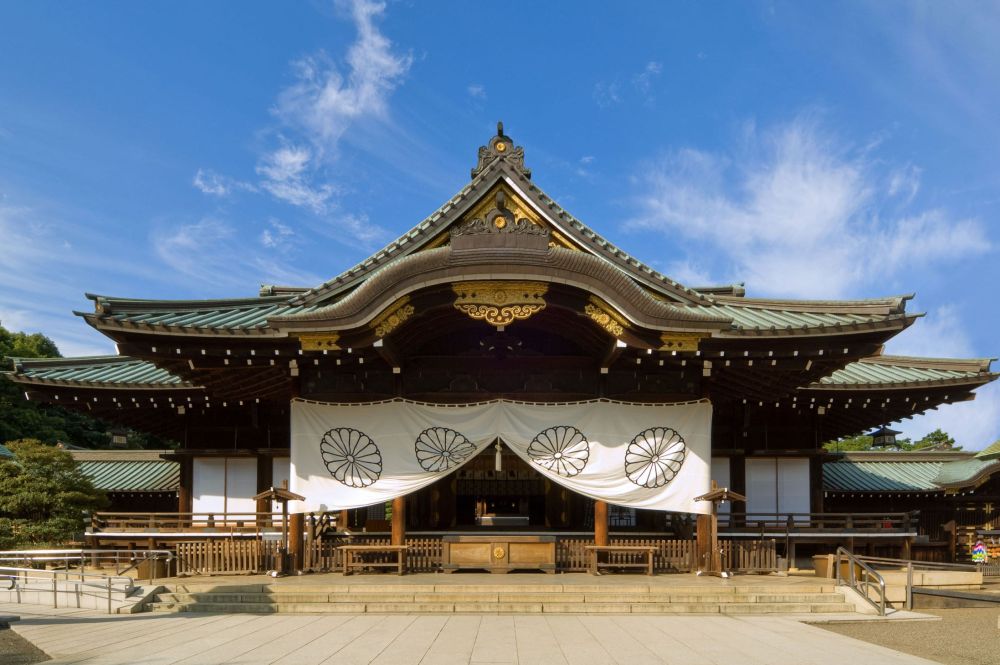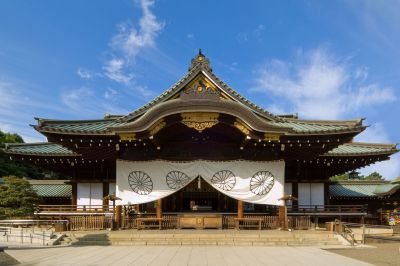

Visitors to Yasukuni Shrine can experience one of the various annual festivals held here. Prominent among them is the Shunki Reitaisai, the shrine's spring festival that occurs in late April. This event, which commemorates the shrine's founding, features a series of traditional ceremonies, including a procession of mikoshi (portable shrines). Attendees can witness priests in ceremonial attire, martial arts demonstrations, and performances of traditional music. The Mitama Matsuri in mid-July honors the spirits of ancestors with thousands of lanterns illuminating the path to the shrine, creating a picturesque and solemn atmosphere that attracts both tourists and locals for remembrance and reflection.
Each spring, Yasukuni Shrine becomes a popular spot for hanami, the traditional Japanese custom of enjoying the transient beauty of cherry blossoms. With hundreds of cherry trees, including the sample tree that the Japan Meteorological Agency uses to officially declare the blossom season in Tokyo, the shrine offers a breathtaking sight. Tourists and locals flock to the shrine with picnic mats to savor the festive atmosphere amidst the falling sakura petals. It's an excellent occasion for photography or to simply relish the natural beauty while indulging in seasonal treats from nearby food stalls.
For history buffs, Yasukuni Shrine provides a deeper understanding of Japan's past through guided tours. These tours give insights into the significance of the shrine, which commemorates over 2.4 million men, women, and children who have died in conflicts serving Japan. Expert guides will also delve into the controversy surrounding the shrine due to its enshrinement of Class A war criminals, a topic that continues to affect diplomatic relations in East Asia. Tours usually include visits to the Yushukan Museum, where artifacts, documents, and wartime memorabilia are on display, providing a more nuanced view of Japan's military history.
Experience the traditional Japanese performing art of Noh at Yasukuni Shrine. Noh is a major form of classical Japanese musical drama that has been performed since the 14th century, involving masks, costumes, and slow, stylized movement. On occasion, the shrine hosts Noh performances that feature stories from classical literature and mythology, offering a unique cultural experience. Attendees can appreciate the subtle beauty of this ancient art form and gain insight into the Japanese aesthetics of simplicity and profundity.
Adjacent to Yasukuni Shrine is the Yushukan War Museum, which is dedicated to the preservation and display of items related to Japan's military history. The museum's exhibits range from feudal warfare to World War II, highlighting the sacrifices of the Japanese people. The collection includes weaponry, personal belongings of fallen soldiers, military vehicles, and aircraft. Despite its controversial interpretation of history, the museum provides a thought-provoking perspective on Japan's role in various conflicts. Visitors can leave with a greater understanding of the complexity of war history as depicted from a Japanese viewpoint.
Yasukuni Shrine is not only for history enthusiasts; it is also a place of exquisite natural beauty. Visitors can stroll the grounds and enjoy the various seasonal flowers that bloom throughout the year. From azaleas in the spring to chrysanthemums in the autumn, the shrine's gardens are meticulously maintained, providing a peaceful escape from the city's hustle and bustle. Photography enthusiasts and nature lovers will find ample inspiration among the vibrant blossoms, picturesque ponds, and traditional stone lanterns that dot the landscape.
The Shuki Reitaisai, or Autumn Festival, takes place in October and showcases a variety of cultural performances and rituals. The highlight is a grand procession that reenacts the return of the spirits of war dead from the battlegrounds to the shrine. Spectators can witness participants dressed in historical samurai armor and clothing. Martial arts demonstrations, traditional music, and dance are also performed. It is a significant event that provides a glimpse into Japan's rich cultural heritage and is a poignant reminder of the country's history.
Throughout the year, Yasukuni Shrine organizes various calligraphy and art exhibitions. These exhibitions often showcase works by both established and up-and-coming artists, providing a platform for visitors to explore the depths of Japanese art. The artwork often reflects themes related to peace, history, and the Shinto religion. Visitors can immerse themselves in the artistry of kanji characters, delicate paintings, and other forms of traditional Japanese art. It’s a unique opportunity to appreciate the aesthetic sensibilities of Japan and perhaps purchase art to take home.
On select occasions, Yasukuni Shrine hosts yabusame events, which are ritualized archery competitions performed on horseback. Dating back hundreds of years, yabusame is a stunning display of martial skill and discipline. Archers clad in traditional costumes ride full speed along a track, firing arrows at three wooden targets. This spectacular event is rooted in Shinto tradition, and its performance is believed to please the deities. Watching yabusame is an exhilarating experience that combines cultural significance with awe-inspiring athleticism.
The Japanese tea ceremony, or 'sado', is a choreographed ritual of preparing and serving Japanese green tea with an emphasis on spirituality and hospitality. Yasukuni Shrine occasionally offers tea ceremony experiences where visitors can participate in this serene practice. Led by tea masters, participants learn about the intricacies of tea preparation, the proper way to consume it, and the philosophy behind each gesture. This contemplative activity allows guests to gain insight into an integral part of Japanese culture that values harmony, respect, purity, and tranquility.
